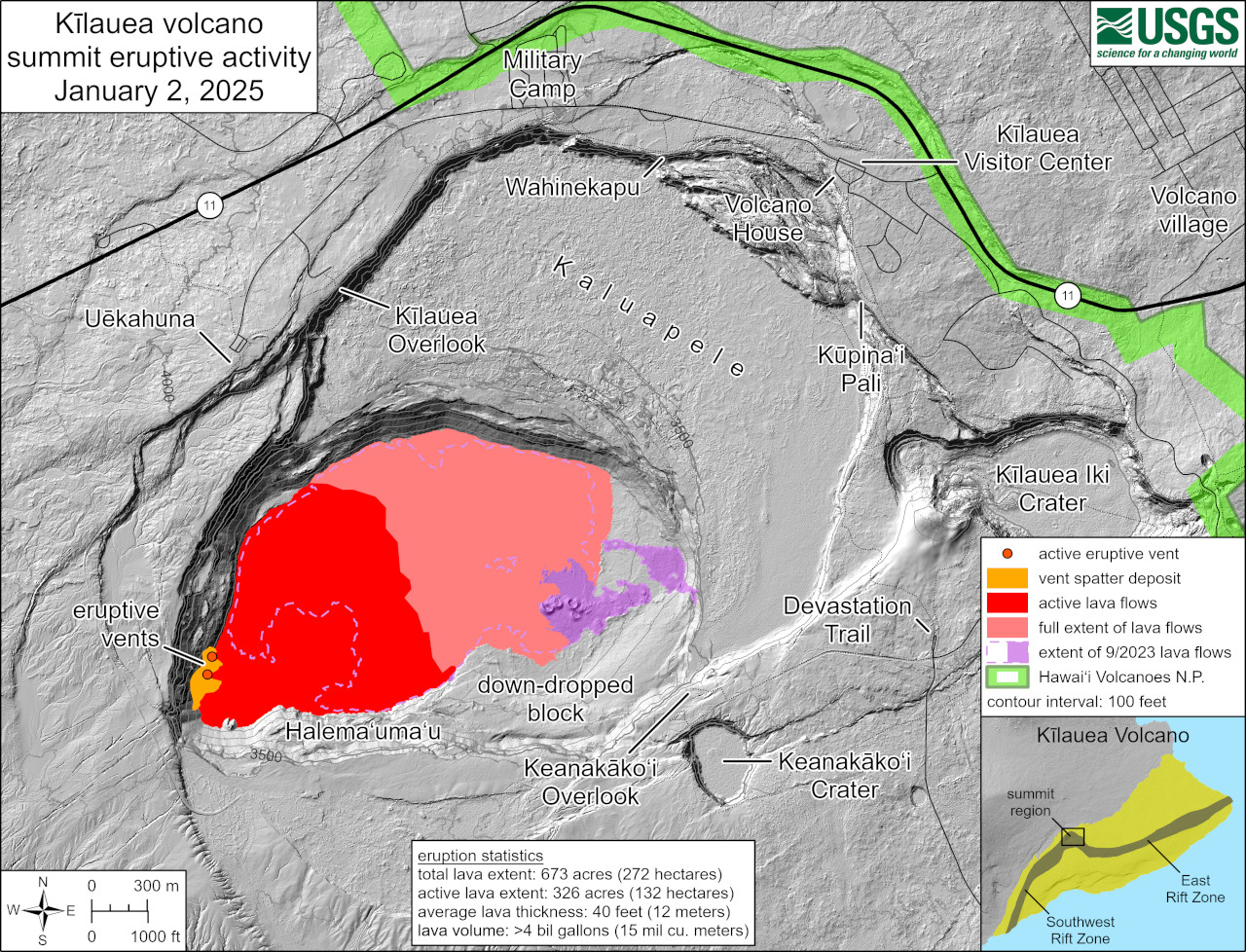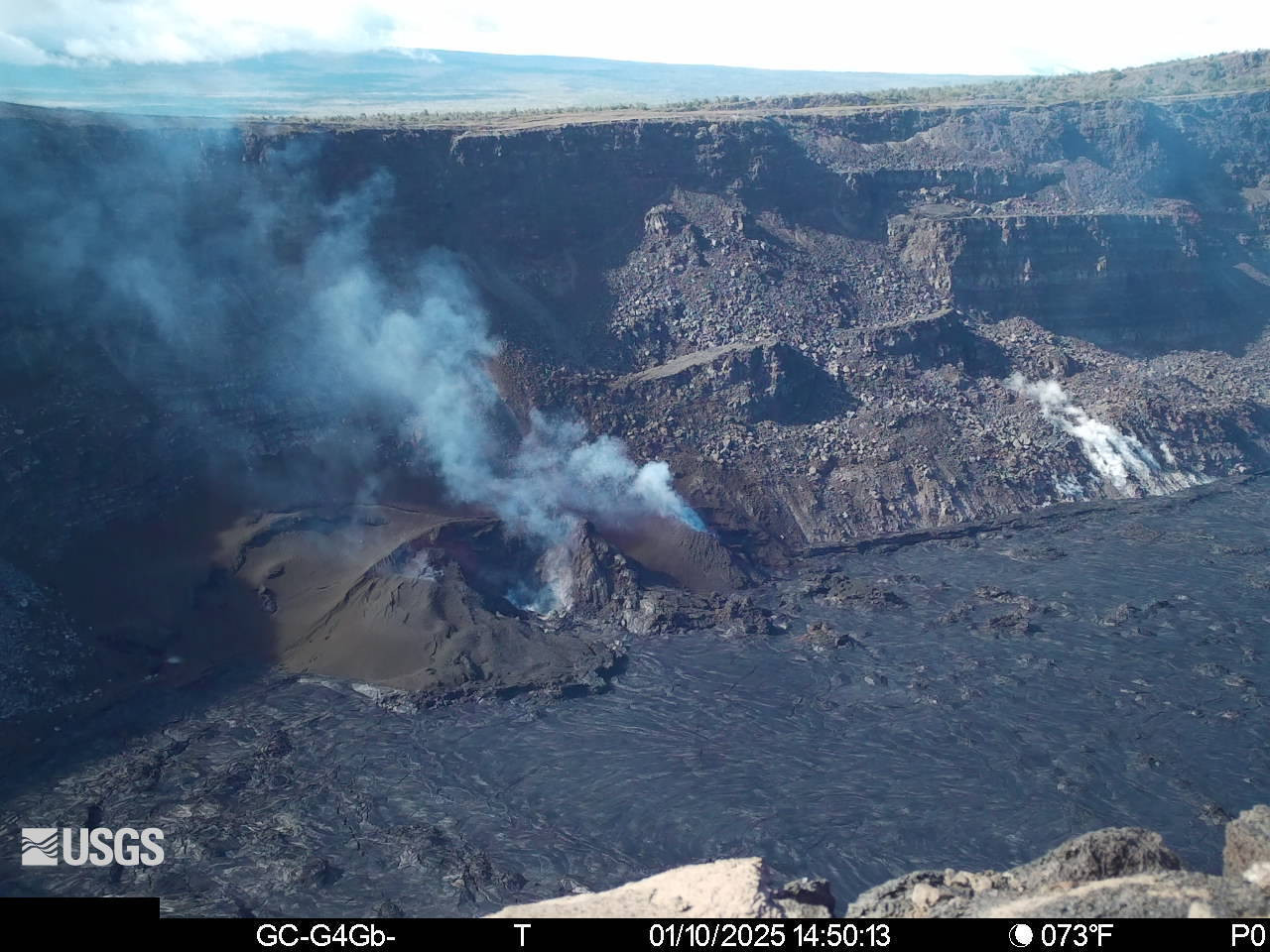(BIVN) – Kīlauea is not erupting, but with signs that new magma is accumulating below the surface of the summit – as well as the ongoing glow from the inactive vents in the caldera – scientists foresee a window of time where lava could once again emerge from the Hawaiʻi island volcano.
The Volcano Alert Level for Kīlauea remains at WATCH. On Friday, the USGS Hawaiian Volcano Observatory issued an information statement, in which it was revealed that a morning helicopter overflight confirmed that lava is visible within both vents within Halemaʻumaʻu. The vents have been emitting a bright glow that has been visible at night on USGS webcams.
From the USGS statement:
EPISODIC ERUPTIONS
The recent eruption of Kīlauea within Halemaʻumaʻu brought back an eruptive style not seen for many years. The eruption included 3 episodes of lava fountaining separated by pauses in eruptive activity. The third pause is ongoing, and USGS Hawaiian Volcano Observatory (HVO) scientists are reviewing patterns of past eruptions and current monitoring data to forecast what could happen next at Kīlauea.
Episodes are marked by the onset of lava fountains and rapid deflation of the source magma chamber. Pauses between fountain episodes are usually accompanied by reinflation of the summit. A new episode begins when the system builds up enough pressure to force magma to the surface again. Fountaining is driven by rapid volume expansion of gas in fresh lava but is commonly preceded by periods of eruption of sluggish degassed flows. Dense degassed material is pushed out of the vent like a cork from a champagne bottle, allowing gas-rich magma to rise rapidly and fountain.
Episodic eruptions have occurred before on Kīlauea at the start of the 1983 Puʻuʻōʻō and the 1969 Maunaulu eruptions (44 and 12 episodes each) on the middle East Rift Zone, and during the 1959 Kīlauea Iki summit eruption (17 episodes). While the recent Kīlauea summit eruption is currently paused, persistent night glow from the vent and continued strong degassing indicate molten magma is probably within 150–300 feet (50–100 meters) of the surface within the vent.
The main feature of episodic eruptions is their repeatability, which allows patterns to be identified. Inflation following episodes 1 and 2 of the recent eruption at the summit of Kīlauea resulted in 6 microradians of ground tilt a tiltmeter north of the caldera, near Uēkahuna bluff, indicating the pressure increase required at that time for the eruption to resume.
WHAT IS LIKELY TO HAPPEN NEXT
It is not possible to forecast an exact outcome of this activity but we are in a window where it is likely another fountaining episode may occur.
Sufficient pressure could push magma up to the surface to start another eruptive episode at Kīlauea summit. Following episode 3, Kīlauea has inflated and the 6 microradian level was reached about 4:30 p.m. HST Wednesday, January 8 afternoon (5 days after episode 3 paused on Friday, January 3 at 8:40 p.m. HST). That amount of inflation had been the minimum amount of pressure required previously for this eruption to restart. However, the large deflation that accompanied the prolonged fountaining of episode 3 suggests the system might need more inflation as recorded on tiltmeters to reach the pressure necessary for eruptive activity to resume.
HVO scientists on a monitoring overflight of Kīlaeua summit the morning of January 10 observed active lava within both vents that erupted recently in Halemʻamaʻu. The longer the vent sits without eruption on the surface, the more time molten material within the vent has to cool and it could reach a point that the eruption can’t restart. Assuming the vent remains open, indicated by continued glow and degassing, and inflation rate remains constant, it seems likely that a new episode could begin sometime between January 8 and January 13, when ground tilt at the Uēkahuna tiltmeter is expected to reach 12 microradians, about double prior post-fountain tilt increases.
Defining windows of time where there is a higher probability or likelihood of an eruption restart differs from more precise forecasts of eruptive activity that require a more specific time for an event to occur. While we know that magma is near the surface, we do not know the exact amount of degassed magma in the vent that is temporarily capping the fresh, gas-rich magma below. The rate of re-pressurization continues to vary as reflected by the changing rate of tilt recorded at Kīlauea’s summit making it difficult to know when enough pressure has accumulated to start forcing degassed magma out of the vent and starting a new episode.

This reference map depicts the Kīlauea summit eruption within Halema‘uma‘u as of January 2, 2025. Since the onset of the eruption on December 23, 2024, it has covered a total of 673 acres (272 hectares) with new lava (pink area), and approximately half that area still hosts active flows (red area). The total lava volume is at least 4 billion gallons (15 million cubic meters), based on measurements from a December 27 overflight and estimates from observations of subsequent activity.
SUMMARY OF RECENT ERUPTIVE ACTIVITY
Tiltmeters and GPS stations showed that the Kīlauea summit region was inflating following the September 15–20, 2024, middle East Rift Zone eruption in and near Nāpau Crater. Inflation rates indicated that a summit eruption or intrusive event could be possible by the end of 2024. At 2:20 a.m. HST on December 23, vents opened in the southwest part of Kaluapele within Hawaiʻi Volcanoes National Park, following approximately a half an hour of elevated earthquake activity. Lava fountains rapidly reaching heights up to nearly 300 feet (91 meters) and fed lava flows that covered the floor of Halemaʻumaʻu crater. Tephra (lava that travels through the air) and Pele’s Hair were deposited downwind of the erupting vents, on a closed portion of Crater Rim Drive. Sulfur dioxide (SO2) emission rates reached up to 140,000 tonnes/day and these elevated volcanic gas emissions were transported downwind, contributing to vog.
Three episodes of eruption have occurred since then, separated by pauses during which little or no lava effusion has occurred:
2:20 a.m. HST to 4:00 p.m. HST December 23, 2024 (14 hours 20 minutes of lava eruption)
8 a.m. HST December 24 to 11 a.m. HST December 25, 2024 (15 hours of lava eruption)
8 a.m. HST December 26, 2024 – 8:30 p.m. HST January 3, 2025 (8 and a half days of lava eruption)
Prior to each episode of eruption, Kīlauea summit tiltmeters showed increasing rates of inflation as pressure accumulated in the magma chambers beneath the surface. With each eruptive episode onset, Kīlauea summit tiltmeters switched to deflationary tilt as that pressure beneath the surface was relieved by lava erupted on the surface. Inflationary tilt returned after each eruptive episode ended, indicating that pressure was again building in the magma chambers beneath Kīlauea summit. In total, the UWD tiltmeter located near Uēkahuna bluff in Hawaiʻi Volcanoes National Park recorded nearly 28 microradians of deflation associated with all three eruptive episodes.
A synthesized text-to-video voiceover was used in the narration for this story. All images and video are courtesy the U.S. Geological Survey and NPS.
Summit eruptions observed over the past 60 years have exhibited vigorous activity in the opening days which can episodically wax and wane, or drop over time to sustainable low effusion rates, or slowly diminish and end.
Recent unrest has been restricted to Kīlauea’s summit region within Hawai’i Volcanoes National Park; earthquake activity remains low at the summit and no unusual activity has been noted in the East Rift Zone or in the Southwest Rift Zone at this time.
This post was originally published on here









